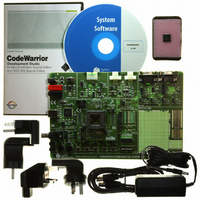EVB9S08DZ60 Freescale Semiconductor, EVB9S08DZ60 Datasheet - Page 283

EVB9S08DZ60
Manufacturer Part Number
EVB9S08DZ60
Description
BOARD EVAL FOR 9S08DZ60
Manufacturer
Freescale Semiconductor
Type
MCUr
Datasheets
1.DEMO9S08DZ60.pdf
(416 pages)
2.EVB9S08DZ60.pdf
(2 pages)
3.EVB9S08DZ60.pdf
(32 pages)
4.EVB9S08DZ60.pdf
(13 pages)
5.EVB9S08DZ60.pdf
(4 pages)
Specifications of EVB9S08DZ60
Contents
Module and Misc Hardware
Processor To Be Evaluated
S08D
Data Bus Width
8 bit
Interface Type
RS-232, USB
Silicon Manufacturer
Freescale
Core Architecture
HCS08
Core Sub-architecture
HCS08
Silicon Core Number
MC9S08
Silicon Family Name
S08D
Kit Contents
Board Cables CD Power Supply
Rohs Compliant
Yes
For Use With/related Products
MC9S08DZ60
Lead Free Status / RoHS Status
Lead free / RoHS Compliant
Available stocks
Company
Part Number
Manufacturer
Quantity
Price
Company:
Part Number:
EVB9S08DZ60
Manufacturer:
TI
Quantity:
101
- DEMO9S08DZ60 PDF datasheet
- EVB9S08DZ60 PDF datasheet #2
- EVB9S08DZ60 PDF datasheet #3
- EVB9S08DZ60 PDF datasheet #4
- EVB9S08DZ60 PDF datasheet #5
- Current page: 283 of 416
- Download datasheet (5Mb)
13.4.5
Reads of this register return the data read from the receive data buffer. Writes to this register write data to
the transmit data buffer. When the SPI is configured as a master, writing data to the transmit data buffer
initiates an SPI transfer.
Data should not be written to the transmit data buffer unless the SPI transmit buffer empty flag (SPTEF)
is set, indicating there is room in the transmit buffer to queue a new transmit byte.
Data may be read from SPID any time after SPRF is set and before another transfer is finished. Failure to
read the data out of the receive data buffer before a new transfer ends causes a receive overrun condition
and the data from the new transfer is lost.
Freescale Semiconductor
Reset
SPTEF
MODF
SPRF
Field
7
5
4
W
R
SPI Data Register (SPID)
Bit 7
SPI Read Buffer Full Flag — SPRF is set at the completion of an SPI transfer to indicate that received data may
be read from the SPI data register (SPID). SPRF is cleared by reading SPRF while it is set, then reading the SPI
data register.
0 No data available in the receive data buffer
1 Data available in the receive data buffer
SPI Transmit Buffer Empty Flag — This bit is set when there is room in the transmit data buffer. It is cleared by
reading SPIS with SPTEF set, followed by writing a data value to the transmit buffer at SPID. SPIS must be read
with SPTEF = 1 before writing data to SPID or the SPID write will be ignored. SPTEF generates an SPTEF CPU
interrupt request if the SPTIE bit in the SPIC1 is also set. SPTEF is automatically set when a data byte transfers
from the transmit buffer into the transmit shift register. For an idle SPI (no data in the transmit buffer or the shift
register and no transfer in progress), data written to SPID is transferred to the shifter almost immediately so
SPTEF is set within two bus cycles allowing a second 8-bit data value to be queued into the transmit buffer. After
completion of the transfer of the value in the shift register, the queued value from the transmit buffer will
automatically move to the shifter and SPTEF will be set to indicate there is room for new data in the transmit
buffer. If no new data is waiting in the transmit buffer, SPTEF simply remains set and no data moves from the
buffer to the shifter.
0 SPI transmit buffer not empty
1 SPI transmit buffer empty
Master Mode Fault Flag — MODF is set if the SPI is configured as a master and the slave select input goes
low, indicating some other SPI device is also configured as a master. The SS pin acts as a mode fault error input
only when MSTR = 1, MODFEN = 1, and SSOE = 0; otherwise, MODF will never be set. MODF is cleared by
reading MODF while it is 1, then writing to SPI control register 1 (SPIC1).
0 No mode fault error
1 Mode fault error detected
0
7
6
0
6
Table 13-7. SPIS Register Field Descriptions
Figure 13-9. SPI Data Register (SPID)
MC9S08DZ60 Series Data Sheet, Rev. 4
5
0
5
4
0
4
Description
3
3
0
Chapter 13 Serial Peripheral Interface (S08SPIV3)
2
0
2
1
0
1
Bit 0
0
0
283
Related parts for EVB9S08DZ60
Image
Part Number
Description
Manufacturer
Datasheet
Request
R
Part Number:
Description:
Manufacturer:
Freescale Semiconductor, Inc
Datasheet:
Part Number:
Description:
Manufacturer:
Freescale Semiconductor, Inc
Datasheet:
Part Number:
Description:
Manufacturer:
Freescale Semiconductor, Inc
Datasheet:
Part Number:
Description:
Manufacturer:
Freescale Semiconductor, Inc
Datasheet:
Part Number:
Description:
Manufacturer:
Freescale Semiconductor, Inc
Datasheet:
Part Number:
Description:
Manufacturer:
Freescale Semiconductor, Inc
Datasheet:
Part Number:
Description:
Manufacturer:
Freescale Semiconductor, Inc
Datasheet:
Part Number:
Description:
Manufacturer:
Freescale Semiconductor, Inc
Datasheet:
Part Number:
Description:
Manufacturer:
Freescale Semiconductor, Inc
Datasheet:
Part Number:
Description:
Manufacturer:
Freescale Semiconductor, Inc
Datasheet:
Part Number:
Description:
Manufacturer:
Freescale Semiconductor, Inc
Datasheet:
Part Number:
Description:
Manufacturer:
Freescale Semiconductor, Inc
Datasheet:
Part Number:
Description:
Manufacturer:
Freescale Semiconductor, Inc
Datasheet:
Part Number:
Description:
Manufacturer:
Freescale Semiconductor, Inc
Datasheet:
Part Number:
Description:
Manufacturer:
Freescale Semiconductor, Inc
Datasheet:











